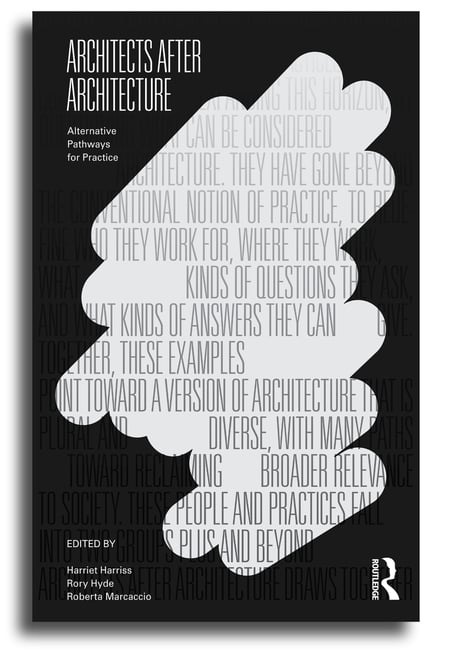The egoist who talks nothing but a linear artistic vision. The employee of an alpha-seeking investor-developer. These descriptions suit some architects, but are despised by most. The variety of contributions by the people featured in Architects After Architecture proves there is more to care about in the built environment than stereotypes.
Curated, written, and edited by Harriet Harriss, Rory Hude, and Roberta Marcaccio, Architects After Architecture is a collection of interviews, articles, and essays about current and former architects around the world who deviated from the standard career path to licensure. These people ventured into various careers and industries but did not leave their architect training behind.
Below are a few notable topics from the reading with some commentary, without giving away the entire book.
Code Amendment
In 2016, MIXdesign's initiative Stalled! proposed an inclusive public bathroom design that later successfully advocated an amendment to the International Plumbing Code (IPC). This amendment, to be implemented in 2021, provides standards and guidelines for constructing all-gender bathrooms.
There are moments when architects review building codes and can not make sense of it. Codes are written in the past, and sometimes the past is twenty years ago, but the social atmosphere changed over the decades. Architects who keep their eyes and ears open always design with social issues in mind if the cause is just. In no way should a design process like this be a compromise.
Social factors have and will always be present, so instead, it is up to the architects to exercise their creativity. The result of Stalled! is the design of a public bathroom that includes all users and an enhanced public space. Five years later, the international code finally recognized the impact of such design, thus the amendment. People change codes, not the other way around.
Humanitarian Aid
The Global Free Unit, a teaching initiative started by Robert Mull in London in 2004, put students in difficult contexts without design prompts. These places include Lesvos of Greece, Izmir of Turkey, and Calais of France, where refugees struggle to find shelter.
So, architecture and design are present throughout the refugee crises, but architects and designers are not.
Ego has no place during a crisis. Students from the program who traveled to refugee camps very soon found out that "innovative" products designed by an architect in an office across the world never improved the refugees' situation. Instead, the students learned from the refugees who survived the unforgiving sea.
Being victims of political conflict is irrelevant to one's skill sets and intelligence. People who do not share the same experience with refugees often overlook the effect of trauma. When one is deprived of basic needs, one loses self-confidence along with possessions. Before constructing shelters, the students' primary effort was to realize refugees as people who are capable of helping the community because they were architects, engineers, city planners, and many other professionals before fleeing their homes.
Development for the Community
The UK-based firm Solidspace, founded by Roger Zogolovitch, is an architect-developer. Equipped with an architect's professionalism and a developer's mindset, Solidspace forms collaborative relationships with its architects.
The infamy of real-estate developers is identical in every part of the world. Public sentiment towards developers is comically extreme such that it is a crime to be a developer. This is because projects have to make money, or buildings simply would not be built. It is not a walk in the park when millions of sourced capital are invested in one project.
High stakes, high stress, high rewards: these are fundamental realizations for anyone who takes part in the game, and nothing can change that. It is no wonder public or even occupant, well-being is often neglected when investor well-being is the priority. Solidspace's achievement, therefore, is unique. Rather than condemning the developer, the architect becomes the developer. That way, projects are in control. The architect's voice is a constant reminder about the greater common goal for all present and future participants of a project.
Technology
Former architects are a common sight in the technology industry workforce. The book features many of them, including a principal designer at Google AI and another who ended up leading the design team at Coinbase.
Digital products grow in complexity year after year, spawning new disciplines that require deep expertise. It is impossible for one person to develop an application that meets modern regulations and consumer expectations, just like an architect and a building. It takes similar minds to lead software development and design buildings.
Here is an example: a mobile application with in-app transactions. The lead developer of this digital product has to guide the user experience (UX) designer to create an effective and handsome interface. At the same time, the developer has to work with cybersecurity consultants on meeting regional fiduciary regulations on digital transactions. The parallels one can draw between lead developers and architects are uncanny. From structural engineers to signage consultants, architects are trained to deal with multiple disciplines, which makes the technology industry familiar and appealing to former architects.
Final Thoughts
Overseeing a project that lasts years trains, architects, to be patient, while instructive architectural details suggest that no problems are too small to ignore, and projects developed through collaboration almost always produce better results. The general skills gained during architectural practice are applicable in many aspects of modern society. With such a skill set, and despite their career paths, the interviewees in the book were guided by purpose and passion over ego and paychecks.
Through Architects After Architecture, we can understand the importance of an architect as a skill set, rather than as a profession.






